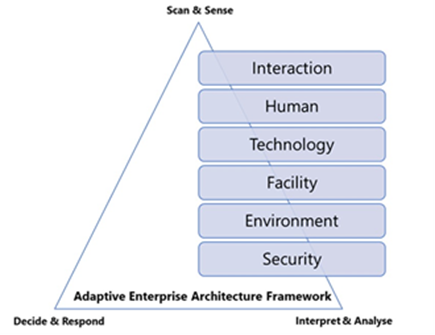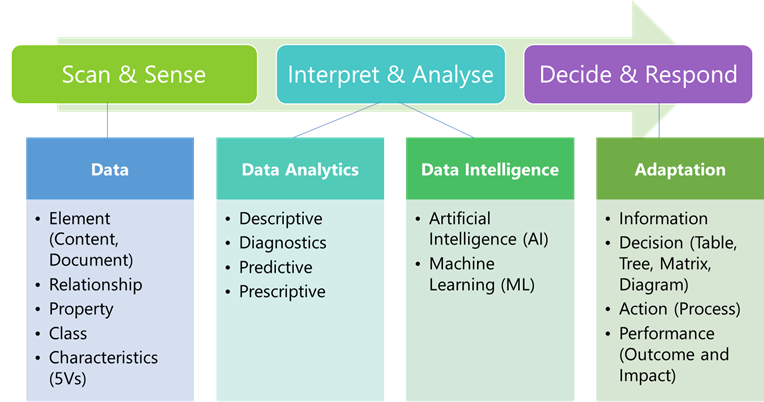by Asif Qumer Gill
University of Technology Sydney, Australia.
Abstract
Enterprise architecture (EA) practice refers to the design decisions about the enterprise structure, behaviour, value proposition and purpose. Decision making needs information. Traditional static visual notation-based modelling and documentation driven approaches to EA are challenged by the continuous adaptation and decision information needs of stakeholders. This article discusses an adaptive EA (AEA) as an information approach to enable adaptation and decision needs, for desired efficiency and innovation (outcomes and impacts). The AEA as information (AEAI) approach uses data, analytics, and intelligence (artificial intelligence, machine learning) capabilities for sourcing architecture data, then converting it into actionable information for decision making. In this sense, AEAI is essentially a decision support framework or system that enables “data to decision” needs of stakeholders. This article provides a synopsis of the AEAI framework, which has been published in the “Adaptive Enterprise Architecture as Information: Architecting Intelligent Enterprises” book: https://doi.org/10.1142/12961.
Keywords: Adaptive, Enterprise Architecture, Data, Analytics, Artificial Intelligence, Machine Learning, Decisions
Introduction
Enterprise architecture (EA) is a key enabler of planning and implementing changes in the design of structure, behaviour, value proposition and purpose of an enterprise for adaptation. Being adaptive refers to ability to handle changes for desired efficiency and innovation. Efficiency refers to sustaining and improving the enterprise. Innovation refers to continuously growing and transforming an enterprise. In the current context of digitalisation, adaptation can refer to using data, analytics, artificial intelligence (AI), machine learning (ML), blockchain, cloud, DevOps, Internet of Things (IoT), mobile and robotics for enabling adaptive digital enterprises. Traditional slow and heavy documentation driven EA practices are challenged by the fast pace digital adaptation and decision information needs. Further, while the EA can be used for digital initiatives, it is also important to look at transforming the EA practice, for architecting digitally enabled intelligent enterprises. This article discusses the adaptive enterprise architecture as information (AEAI) to support adaptation decisions and actions for desired efficiency and innovation (outcomes and impacts). The information driven AEAI approach uses data, analytics, and intelligence (AI/ML) for architecting intelligent enterprises.
Adaptive Enterprise Architecture as Information
AEAI is organised into six interacting architecture information layers or domains: interaction, human, technology, facility, environment and security. Additional layers can be defined as required to address the specific information needs for decision making. Interaction layer specifies the information and decision about the interactions between the human, technology, facility and environment elements. Human centric layer specifies the business, information, social and professional architecture elements and related information and decisions. Technology centric layer specifies the information and decisions about the application, data, platform and infrastructure elements. Facility centric layer specifies the information and decisions about the spatial, energy, HVAC (heating, ventilation and air conditioning) and FHS (fire, health and safety) elements. Environment centric layer specifies the information and decisions about political, economic, social, technological, environmental and legal elements. Security is an overarching layer that considers AEAI elements as assets (architecture information as an asset) and focuses on their resilience based on asset value and risk.
The AEAI focuses on the information-driven capability to continuously scan and sense the internal and external environment architecture across layers for data about known and unknown events (complex event processing), changes or disruptions, interpret and analyse the collected data, and decide and respond based on intuition and rationale to expected and unexpected changes (threats and or opportunities) for adaptations (Figure 1) (Gill 2015). This draws our attention to the topic of data to decision in the AEAI approach.

Figure 1. Adaptive EA as Information (Gill 2022)
Data to Decision Value Chain
The AEAI approach requires establishing the AEA information fabric (AIF) or enterprise knowledge graph. The AIF provides an integrated access to AEA raw data from different sources and repositories. The AEA data can be searched and discovered (scan and sense) from different sources via AIF. The AEA data can be processed (interpret and analyse) using data analytics and intelligence capabilities obtaining the actionable information. The AEA information can be used for making informed decisions (decide and respond) for adaptation. This creates a data to decision value chain. In summary, AEA data is converted into information, and AEA information is then used in decision making.
A decision can have several other elements, and AEA information is only one of the six key elements of a decision (Howard and Abbas 2015):
- the decision-maker
- a frame
- alternatives from which to choose from
- preferences
- information
- the logic by which the decision is made
Information (data, analytics, intelligence), along with other decision elements, can be embedded in AEA for defining the AEAI as a decision support system.

Figure 2. Adaptive EA as Information – Data to Decisions (Gill 2022)
Data
Architecture data model can be created to specify the architecture data. It can include elements or entities including contents and documents and their relationships. Both the entities and their relationships have proprieties or attributes. Elements, relationships and properties belong to certain class or type. Further, data can different characteristics such as variety, velocity, volume, value and veracity.
Information
There are different types of data analytics and intelligence models that can process the data to turn into a useful information. We can generate descriptive, diagnostics, predictive and prescriptive models of the architecture data. Further, we can use AI/ML.
Decision
The information can be used as an input in the adaptation process for making decisions. Here, we can use decision tables, trees, matrices and diagrams to arrive at the decision for desired actions and performance outcomes.
Conclusion
EA is often considered as a documentation heavy practice. This article provided an overview of the information-driven AEAI approach from the “Adaptive Enterprise Architecture as Information: Architecting Intelligent Enterprises” book. This provides new perspectives in terms of provisioning the architecture information for making adaptation decisions. It also pointed out data, analytics, intelligence and decision models as a part of the data to decision value chain.
References
- Gill, A.Q. Adaptive Enterprise Architecture as Information: Architecting Intelligent Enterprises. World Scientific, 2022. https://doi.org/10.1142/12961.
- Gill A.Q. Adaptive Cloud Enterprise Architecture. World Scientific, 2015. https://doi.org/10.1142/9363.
- Howard, R.A. and Abbas. A.E. Foundations of Decision Analysis. Prentice Hall, NY, 2015.
About the Author
Asif Gill is a result-oriented academic cum practitioner with extensive 20+ years’ experience in IT in various sectors including banking, consulting, education, finance, government, non-profit, software, and telecommunication. He is A/Professor & Leader of the DigiSAS Lab at the School of Computer Science, UTS. He is also director and founder of the start-up “Infoagility” (Adapt Inn Pty Ltd). His earlier professional experience in agile software development, solution architecture, information architecture, information security, and program management provided a strong foundation for later work in digital strategy, architecture, and solutions. He is recognised as a leader and specialist in adaptive enterprise & information architecture for designing and implementing large scale digital data ecosystems and platforms. He received his Ph.D. and M.Sc. in computing sciences. He is also certified as a CISM, DVDM, DCAM, ITILv3, and TOGAF.








